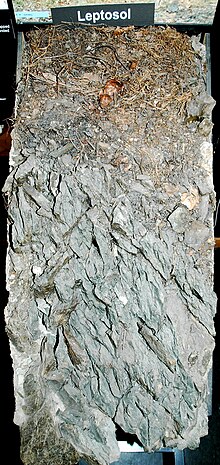Leptosol
Leptosol (LP) ( ancient Greek λεπτός leptós "thin") is one of the 32 reference soil groups of the World Reference Base for Soil Resources (WRB). The group includes shallow and poorly developed soils over continuous rock (on different parent rock) and extremely skeletal soils.
Diagnostic features
Leptosols either have a depth limitation due to the rock within 25 cm of the terrain surface or have less than 20% by volume of fine soil in the upper 75 cm below the terrain surface.
distribution
The reference soil group of the Leptosols is the largest with a distribution of 1.65 million hectares and occurs worldwide in all climates and altitudes, but mainly in mountain regions as the initial phase of soil development or often as a form of degradation (through erosion) of former deeper soils.
Properties and use
Leptosols have a low water storage capacity and are poor in nutrients due to their shallow depth. This results in restricted usability, which is then largely limited to forest or pasture use.
Corresponding to the Central European soil nomenclature
Since the definitions given in the WRB different from those valid for Germany criteria Leptosols include in the German nomenclature both Syroseme and Lockersyroseme and parts of the rock humus soils , skeletal humus , ranker , Rendzinas and Pararendzinas .
Web links
- Profile photos (with classification) WRB homepage
- Profile photos (with classification) IUSS World of Soils
literature
- IUSS Working Group WRB: World Reference Base for Soil Resources 2014, Update 2015. World Soil Resources Reports 106, FAO, Rome 2015. ISBN 978-92-5-108369-7 ( PDF 2.3 MB).
- W. Zech, P. Schad, G. Hintermaier-Erhard: Soils of the world. 2nd Edition. Springer Spectrum, Heidelberg 2014. ISBN 978-3-642-36574-4 .
- W. Amelung, H.-P. Blume , H. Fleige, R. Horn, E. Kandeler , I. Kögel-Knabner , R. Kretschmar, K. Stahr , B.-M. Wilke: Scheffer / Schachtschabel textbook of soil science. 17th edition. Heidelberg 2018. ISBN 978-3-662-55870-6 .

